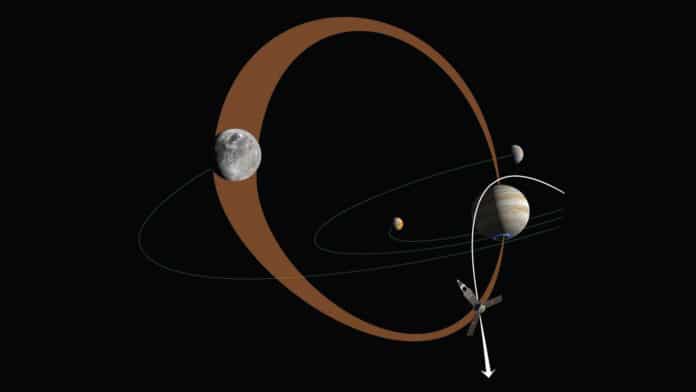Jupiter’s auroras are significantly more intense than Earth’s, and unlike Earth, Jupiter’s largest moons also create auroral spots. The Galilean moons- the four largest moons of Jupiter—Io, Europa, Ganymede, and Callisto- create their auroras on Jupiter’s north and south poles. Each auroral footprint is magnetically connected to its respective moon. It’s like a magnetic leash that connects the moon glowing to Jupiter.
The Juno mission orbits Jupiter, collecting science data and providing dazzling views of Jupiter and its satellites. On November 8, 2020, Juno flew through an intense beam of electrons traveling from Ganymede, Jupiter’s largest moon, to its auroral footprint on the gas giant.
Using data from Juno’s payload, scientists from Southwest Research Institute studied the particle population traveling along the magnetic field line connecting Ganymede to Jupiter while simultaneously remotely sensing the associated auroral emissions to unveil the mysterious processes creating the shimmering lights.
The mini-magnetosphere of Ganymede interacts with Jupiter’s massive magnetosphere. This interaction creates waves that accelerate electrons along the gas giant’s magnetic field lines.
Two SwRI-led instruments on Juno, the Jovian Auroral Distributions Experiment (JADE) and the Ultraviolet Spectrometer (UVS) provided key data for this study, supported by Juno’s magnetic field sensor built at NASA’s Goddard Space Flight Center. JADE measured the electrons traveling along the magnetic field lines, while UVS imaged the related auroral footprint spot.
Along these lines, Juno can quantify the electron “rain” and quickly notice the UV light it creates during interaction with Jupiter. Past Juno estimations showed large magnetic perturbations accompanied the electron beams causing the auroral footprint. Be that as it may, this time, Juno didn’t notice similar perturbations with the electron beam.
Dr. Bertrand Bonfond, a co-author of the study from the Liège University in Belgium, said, “If our interpretation is correct, this is a confirmation of a decade-old theory that we put together to explain the morphology of the auroral footprints. The theory suggests that electrons accelerated in both directions create the multi-spot dance of auroral footprints.”
Hue said, “The Jupiter-Ganymede relationship will be further explored by Juno’s extended mission, as well as the forthcoming JUICE mission from the European Space Agency. SwRI is building the next generation of UVS instrumentation for the mission.”
Journal Reference:
- V. Hue et al. A Comprehensive Set of Juno In Situ and Remote Sensing Observations of the Ganymede Auroral Footprint. DOI: 10.1029/2021GL096994
